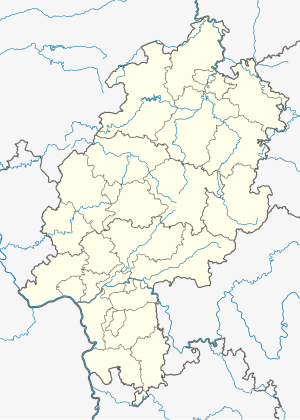Buhlen Viaduct
Coordinates: 51 ° 10 '42 " N , 9 ° 5' 54" E
| Buhlen Viaduct | ||
|---|---|---|
| Convicted | - formerly: Ederseebahn | |
| Subjugated | Networks and federal highway 485 | |
| place | Buhlen , municipality of Edertal, North Hesse | |
| construction | Arch bridge made of stamped concrete | |
| overall length | 153 m | |
| height | 30 m | |
| start of building | September 1907 | |
| completion | November 1908 | |
| opening | February 1, 1909 | |
| closure | 1995 | |
| location | ||
|
|
||
| Above sea level | 210 m above sea level NHN | |
|
Bridge with 6 arches, each 19.50 m wide |
||
The Buhlener Viaduct is a six-arched, 153 m long and 30 m high railway bridge of the disused Ederseebahn , between the districts of Buhlen and Mehlen in the municipality of Edertal in the north Hessian district of Waldeck-Frankenberg ( Germany ).
Geographical location
The viaduct bridges the valley of the Netze , a tributary of the Eder , and the federal road 485 about 1.5 km (as the crow flies ) southeast of Buhlen or 900 m east of the Buhlen train station and 800 m northwest of the traffic circle on the B 485 and the state road L. 3383 at Mehlen-Lieschensruh. The bridge is located at kilometer 10.7 (from Bad Wildungen ) or 27.9 (from Wabern ) of the single-track Ederseebahn , which was closed in this section in 1995 and is the middle section of the Wabern – Brilon-Wald railway .
Bridge data
The arch bridge has a total length of 153 m between the outer edges of the wing walls and its greatest height above the valley floor is around 30 m. 33.66 m of its total length lie in a straight line at the eastern end, the remaining part describes an arc of 700 m radius open to the south . Six bridge arches, each 19.33 m or 19.50 m clear width and 7.5 m arrow height, span the valley. The five pillars have buttresses with an approach angle of about 1:11 on all four sides, are set up radially in the curve of the bridge and are partly on rock and partly on firm, sandy loam soil . The second and fourth pillars are designed as group pillars, with a larger plan and diameter than the other three, in order to enable the vaults to be constructed in three sections; however, the four western vaults were built at the same time to speed up the completion of the viaduct. Since the upper edge of the bridge has a continuous gradient from east to west of 1:75, the vaults are designed with inclined transom lines . Excluding the arched abutments above the pillar cornices , the span of the vaults is 18.2 m, the arrow height 5.5 m.
The bridge is made of stamped concrete . The gravel was brought from the Eder to the construction site on a narrow-gauge railway . The concrete was transported up there by an elevator and then brought to the desired location along the work scaffolding. A total of 2810 m³ of foundation concrete, 4730 m³ of rising concrete, 760 m³ of vaulted concrete, 650 m³ of filler concrete and 75 m³ of stone for cantilevers and cover plates were used. About 5100 m³ of earth were excavated for the foundation of the pillars and abutments.
The viaduct was given an appealing exterior that is still visible today by covering the visible surfaces with facing concrete made of colored cement: the pillars, vaults, cornices, cover plates and parapets are reddish, the front walls above the vaults are light gray and the niches in the front walls are dark gray.
history
The viaduct was built from September 1907 to November 1908 by B. Liebold & Co. AG from Holzminden , as part of the Bad Wildungen –Buhlen section of the Wabern – Brilon-Wald railway that opened on February 1, 1909 . Trains ran over the viaduct until May 27, 1995. Then the line from Bergheim to Korbach was shut down, not least because the Buhlen Viaduct was in disrepair.
The section from Korbach to Buhlen train station was converted from 2008 to 2012 into the Ederseebahn cycle path ( long-distance cycle path R6). The Buhlen Viaduct was not included in the cycle path because of the high costs of a fundamental renovation, and this therefore ends quite abruptly at the Buhlen train station or on the K 34 district road from Buhlen to Affoldern .
literature
- F. Emperger (Hrsg.): Handbuch für Eisenbetonbau (Third revised edition), Seventh Volume: Th. Gesteschi (Ed.): Arched bridges and vaults. W. Ernst & Sohn, Berlin, 1921, pp. 259-261 (with detailed construction drawings)
Web links
- Photos of the bridge BAS 5438 - Buhlener Viadukt, at brueckenweb.de
- Buhlen Viaduct, at mapio.net (photo gallery)
Individual evidence
- ↑ Different mixing ratios of cement to aggregate were specified for the various elements of the building .
- ↑ http://www.bahntrassenradwege.de/index.php?page=ederseebahn-radweg-2
